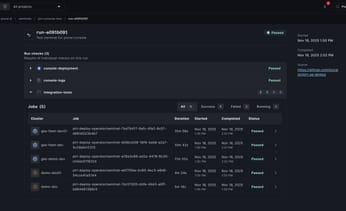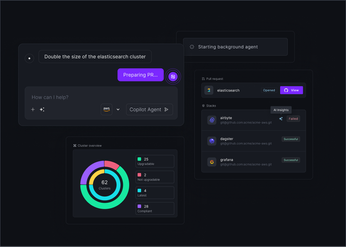
Kubernetes IDP: The Ultimate Guide for Platform Teams
Get a practical overview of IDP for Kubernetes, including key features, benefits, and actionable steps for building a scalable internal developer platform.
Platform engineering teams face a constant tension: giving developers the autonomy to ship quickly while retaining control over security, cost, and reliability. Without the right framework, the platform team becomes a bottleneck, stuck resolving tickets for provisioning and deployment.
A Kubernetes-based Internal Developer Platform (IDP) addresses this challenge by offering a curated, self-service experience. Developers get access to pre-approved tools, environments, and application templates, while the platform team embeds governance and best practices into the workflows by default. The result is a shift from gatekeeping to enabling developer productivity at scale.
Unified Cloud Orchestration for Kubernetes
Manage Kubernetes at scale through a single, enterprise-ready platform.
Key takeaways:
- Treat your IDP as an internal product, not a project: An IDP’s core function is to abstract Kubernetes complexity and provide a standardized, self-service path for developers. This reduces their cognitive load while enabling platform teams to enforce security and operational standards at scale.
- A successful IDP is built on integrated, non-negotiable features: Foundational components include Infrastructure as Code (IaC) automation for reproducible environments, a service catalog for developer autonomy, and centralized RBAC for consistent security across your entire fleet.
- Implementation is the beginning, not the end: The long-term value of an IDP depends on continuous optimization. Proactively maintain the platform, plan for scale, and measure its success against key engineering metrics like deployment frequency and mean time to recovery (MTTR).
What Is a Kubernetes IDP?
An IDP is a layer of tooling and automation built by platform teams to give developers self-service capabilities for managing applications and infrastructure. In a Kubernetes environment, an IDP abstracts away cluster complexity—manifests, YAML, kubectl commands—and provides a streamlined path for building, deploying, and operating workloads.
This creates a clear contract between platform and development teams:
- Platform teams define standardized tools, security policies, and infrastructure.
- Developers consume these resources through a simple interface—such as a portal, CLI, or API.
The result is faster delivery for developers and stronger governance for platform teams. A good IDP doesn’t just stitch tools together—it integrates them into a cohesive workflow spanning version control, CI/CD, monitoring, and operations.
Core Components and Architecture
A Kubernetes IDP typically includes:
- Platform API & orchestration engine – translates developer requests into Kubernetes actions.
- Developer portal / UI – the primary interaction layer, often including a service catalog for apps and infrastructure.
- Integration with DevOps toolchain – connects to Git repositories, CI/CD pipelines, container registries, observability stacks, and policy engines.
Well-known implementations include Backstage (service catalog & portal), Crossplane (infrastructure orchestration), and Argo CD (GitOps deployment). Some commercial platforms, like Plural combine these pieces into a single system with agent-based management across clusters.
Key Benefits for Engineering Teams
For developers:
- Reduced cognitive load—no need to master Kubernetes internals.
- Self-service workflows—scaffold services, deploy apps, and provision infra without tickets.
- Faster iteration—focus on product features instead of YAML and kubeconfigs.
For platform teams:
- Enforced standards—security, compliance, and cost policies embedded into workflows.
- Consistency at scale—reduce configuration drift with GitOps-driven automation.
- Higher leverage—fewer support tickets, more focus on improving platform reliability.
This balance turns the platform team from gatekeepers into enablers of developer velocity.
How an IDP Workflow Operates
A typical Kubernetes IDP workflow automates the full code-to-production lifecycle:
- Scaffold a service – developer selects a template (e.g., API service, job, or frontend) via the portal.
- Push code to Git – repository contains both app code and deployment manifests.
- CI/CD pipeline runs – builds container image, runs tests, performs security scans.
- GitOps syncs deployment – tools like Argo CD or Flux ensure the live cluster matches the desired state in Git.
- Observability hooks – logs, metrics, and traces flow into the platform automatically.
Every change is versioned, reviewed, and auditable. Rollbacks are as simple as reverting a commit. This workflow makes deployments faster, safer, and more predictable.
Essential Features of a Kubernetes IDP
A Kubernetes IDP isn’t just a bundle of tools. Its value lies in how tightly those tools are integrated to create a paved path for developers while giving platform teams the ability to enforce governance at scale. A strong IDP standardizes workflows, automates repetitive tasks, and embeds security by design—helping both developers and operators focus on higher-value work.
When evaluating or building an IDP, the following features are foundational. Together, they form the backbone of a secure, scalable, and efficient software delivery lifecycle on Kubernetes.
1. Infrastructure as Code Integration
An IDP must treat infrastructure the same way we treat application code: version-controlled, auditable, and reproducible. Tight integration with IaC tools like Terraform ensures environments are provisioned automatically and consistently. This prevents configuration drift and eliminates fragile manual workflows.
Platforms like Plural Stacks extend this by offering a Kubernetes-native framework for Terraform. Commits and pull requests can automatically trigger Terraform runs, surfacing plans and applies directly within the platform UI.
2. Service Catalogs & Self-Service Provisioning
A core goal of an IDP is to remove ticket-driven bottlenecks. Developers should be able to provision approved infrastructure and tools on-demand, without waiting on the platform team.
A service catalog makes this possible by presenting pre-vetted templates and components (databases, monitoring agents, app scaffolds, etc.). With Plural’s Self-Service Catalog, developers gain autonomy while the platform enforces security policies, resource quotas, and compliance guardrails automatically.
3. Centralized Access Control
Managing authentication and RBAC across multiple Kubernetes clusters is notoriously complex. A Kubernetes IDP should centralize identity and access management, ensuring consistent, secure policies across environments.
Plural integrates with OIDC-based SSO providers, mapping console identities directly to Kubernetes impersonation. RBAC rules for users and groups can then be synced across an entire fleet using Plural Global Services, eliminating the need to manually manage kubeconfigs per cluster.
4. Integrated Monitoring & Observability
An IDP’s role doesn’t end at deployment—it must also support ongoing visibility and troubleshooting. Developers and operators need unified access to logs, metrics, and traces without hopping between siloed tools.
Plural’s built-in multi-cluster dashboard delivers this single-pane-of-glass view, offering real-time health checks, pod-level metrics, and network insights. Its egress-only architecture ensures observability without exposing sensitive cluster endpoints.
For broader observability stacks, many IDPs also integrate with Prometheus, Grafana, and OpenTelemetry.
5. CI/CD Pipeline Management
At the heart of any IDP is the delivery pipeline. This goes beyond running builds—an IDP should orchestrate deployments, detect drift, and guarantee consistency across clusters.
Plural CD, for example, uses a GitOps-style pull model: lightweight agents on each cluster continuously reconcile manifests from Git. This ensures clusters always reflect the desired state defined in code—reducing deployment failures and simplifying rollbacks.
How to Choose an IDP Solution
Selecting an IDP isn’t just a feature checklist—it’s a strategic decision that shapes developer experience, operational efficiency, and scalability. The right choice should fit your workflows, technical stack, and long-term goals. A structured evaluation process helps cut through vendor marketing and focus on measurable value: define clear criteria, build a comparison framework, analyze true costs, and create an implementation roadmap.
Key Selection Criteria
An IDP must support multiple personas—developers, platform engineers, and SREs—without adding friction. Look for solutions that provide:
- IaC integration with tools like Terraform or Pulumi
- Service catalogs for self-service provisioning. (Backstage is the most widely used open-source option.)
- Centralized access control with features like RBAC, SSO, and audit logging.
- Native integrations with Git repositories, CI/CD systems, monitoring tools, and secrets management.
The architecture should be scalable, secure, and enforce governance across your Kubernetes fleet.
Build an Evaluation Framework
Adopting an IDP means introducing new tools and workflows. To avoid disruption, start by mapping use cases to your biggest pain points—for example:
- Reducing service provisioning time.
- Standardizing deployment pipelines.
- Improving observability and incident response.
Create a scorecard to evaluate solutions (including in-house builds) against these criteria. Validate top contenders with a proof of concept (POC): pick a real project, assign a small team, and test integrations in your environment. This approach gives you more signal than vendor demos alone.
Analyze Total Cost of Ownership
The sticker price of an IDP is only part of the equation. A true Total Cost of Ownership (TCO) should include:
- Direct costs: licensing, support contracts.
- Engineering time: implementation, integrations, ongoing maintenance.
- Operational overhead: upgrades, security patches, bug fixes, user support.
- Training & adoption: time to onboard teams and document workflows.
Building an IDP in-house (e.g., on Backstage) offers flexibility but requires a dedicated team to maintain it as a product. Commercial solutions can reduce maintenance load but come with subscription costs. Compare both paths against expected productivity gains—such as faster onboarding or reduced ticket volume.
Create an Implementation Roadmap
Rolling out an IDP should be incremental. Start with a pilot team to validate the platform and gather feedback. From there:
- Define a “golden path”—a standardized workflow (e.g., deploying a new microservice) with pre-approved infrastructure templates.
- Use early feedback to refine templates and platform features.
- Expand onboarding gradually, adding more teams and capabilities over time.
This phased approach ensures adoption, minimizes risk, and prevents platform teams from becoming a bottleneck.
How to Optimize Your IDP
Implementing an Internal Developer Platform is not a one-time project. To extract maximum value, you must continuously refine and optimize it based on performance data, user feedback, and evolving organizational needs. A successful IDP is a living system that adapts to your engineering workflows, not a static toolset that forces them into a rigid structure. The following practices will help you maintain a high-performing, scalable, and user-centric platform.
Optimize for Performance
An IDP's primary goal is to accelerate development, so its own performance is critical. A slow or unreliable platform creates friction and undermines developer trust. By providing a curated and standardized environment, an IDP should streamline operations, not hinder them. This means optimizing everything from CI/CD pipeline execution times to the responsiveness of the user interface.
Plural is built on a scalable, agent-based pull architecture that avoids networking-intensive Kubernetes watch streams, ensuring the platform remains performant even as your fleet grows. To further optimize, regularly monitor resource utilization within your clusters using the embedded Kubernetes dashboard. Analyze build and deployment logs to identify bottlenecks, and enforce the use of efficient, minimal base container images to speed up deployment cycles.
Plan for Platform Maintenance
Like any critical infrastructure, your IDP requires regular maintenance to remain secure and effective. Neglecting updates can lead to security vulnerabilities, compatibility issues, and performance degradation. Establishing a proactive maintenance schedule is essential for long-term success and helps you anticipate the challenges of a new platform.
Plural simplifies this process by managing its deployment agents and providing tools for consistent fleet-wide updates. You can use Plural’s GlobalService CRD to roll out changes, such as updated RBAC policies or security patches, across all your clusters from a single definition. This ensures uniformity and reduces the operational burden of manual updates. Schedule regular reviews of all IDP components, including CI/CD runners, monitoring agents, and integrated tools, to apply necessary patches and version upgrades.
Improve Team Collaboration
An IDP should act as a bridge between teams, not a silo. It must serve the needs of diverse user personas—from developers who need self-service capabilities to platform engineers who manage the underlying infrastructure. When configured correctly, an IDP can enhance collaboration across teams by providing a shared, consistent interface for interacting with Kubernetes.
Plural’s Self-Service Catalog allows platform teams to define standardized infrastructure components that developers can deploy with confidence. This reduces handoffs and empowers developers to manage their application lifecycle. Furthermore, Plural’s centralized dashboard uses Kubernetes impersonation with SSO integration, allowing you to define fine-grained RBAC policies for different teams and users. This gives everyone the access they need without compromising security, fostering a more collaborative and efficient environment.
Measure Success
To justify the investment in an IDP and guide its evolution, you must measure its impact. Without clear metrics, it’s impossible to know if the platform is meeting its goals or where improvements are needed. Establishing KPIs helps you assess the effectiveness of the platform and demonstrate its value to the organization.
Start by defining metrics that align with your engineering goals, such as deployment frequency, lead time for changes, change failure rate, and mean time to recovery (MTTR). Plural’s dashboard provides deep visibility into cluster state and deployment history, giving you the raw data needed to track these KPIs. You can also measure developer satisfaction through surveys and feedback sessions to capture the qualitative impact of the IDP on daily workflows.
Plan for Scale
As your organization grows, your IDP must scale with it. A platform designed for a handful of services and a single cluster will quickly break down in a multi-cluster, multi-cloud environment. Careful planning for scale is essential to support an increasing number of developers, applications, and infrastructure resources without compromising performance or stability.
Plural is architected for scale, using an egress-only agent to manage clusters across any cloud, on-prem data center, or edge location from a single control plane. This model eliminates the need for complex networking configurations like VPNs. For managing infrastructure complexity, Plural Stacks provides a Kubernetes-native workflow for running Terraform at scale. By building your IDP on a foundation designed for fleet management, you ensure it can handle future growth without requiring a complete re-architecture.
Related Articles
Unified Cloud Orchestration for Kubernetes
Manage Kubernetes at scale through a single, enterprise-ready platform.
Frequently Asked Questions
What's the real difference between an IDP and just using a collection of CI/CD and DevOps tools? The key difference is integration and the creation of a standardized workflow. A collection of tools often results in a fragmented experience where developers have to piece together different systems, each with its own interface and configuration. An IDP unifies these components into a single, cohesive platform with a consistent API and UI. It creates a "paved path" that guides developers through building, deploying, and operating their services, abstracting away the underlying complexity while ensuring best practices are followed automatically.
How does an IDP give developers self-service capabilities without compromising on security and standards? An IDP achieves this by enabling platform teams to define and curate the resources developers can use. Instead of giving developers direct access to raw infrastructure, the platform team creates a service catalog of pre-approved, pre-configured components. For example, Plural’s Self-Service Catalog allows platform teams to offer standardized application templates or infrastructure modules that already have security policies, resource limits, and compliance rules baked in. This way, developers gain the autonomy to provision what they need on-demand, while the platform team maintains central control over governance.
We have clusters in different clouds and on-prem. How does an IDP manage access and deployments consistently across them? A well-architected IDP uses a model that doesn't depend on direct network access to every cluster. Plural, for instance, uses a lightweight agent installed on each managed cluster. This agent communicates with the central control plane using a secure, egress-only connection. This design means you can manage clusters in private VPCs, on-premises data centers, or even on a developer's laptop without configuring complex VPNs or exposing cluster API endpoints. Deployments and RBAC policies can then be pushed out consistently to the entire fleet from a single interface.
Building our own IDP seems like a huge project. What are the main trade-offs compared to using a platform like Plural? Building an IDP from scratch gives you complete control, but it requires treating the platform as an internal product with a dedicated engineering team for development and long-term maintenance. The total cost of ownership goes far beyond the initial build, including ongoing updates, bug fixes, security patching, and user support. A managed platform like Plural provides the core IDP functionality out of the box, allowing your team to focus on configuring workflows rather than building and maintaining the underlying infrastructure. This significantly reduces the operational burden and accelerates the time it takes to deliver value to your developers.
How can we introduce an IDP without forcing a massive, disruptive change on our engineering teams? A successful rollout is gradual and iterative. Instead of a "big bang" launch, start with a pilot program involving a single team and a well-defined use case, often called a "golden path." This could be a standardized workflow for deploying a new microservice. By proving the value on a small scale, you can gather feedback, refine the process, and build advocacy. Once the initial path is successful, you can gradually onboard more teams and expand the IDP's capabilities based on real user needs, ensuring a smoother adoption process.
Newsletter
Join the newsletter to receive the latest updates in your inbox.









